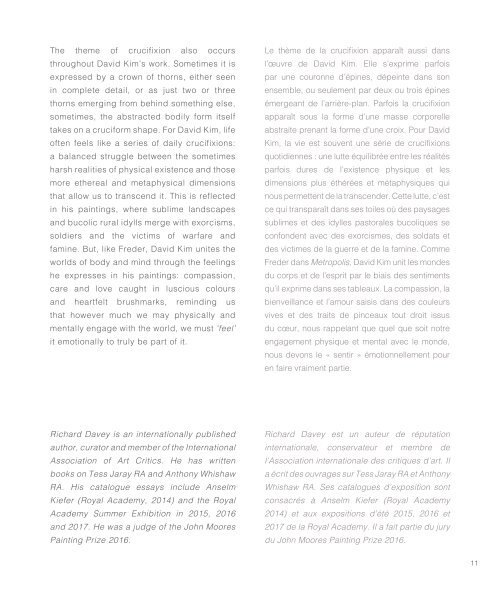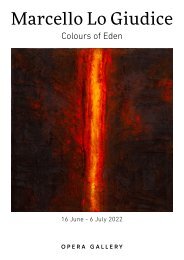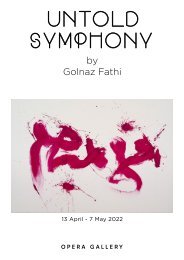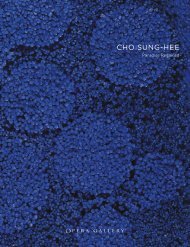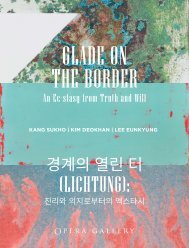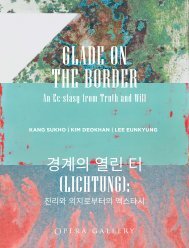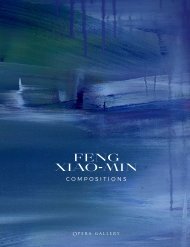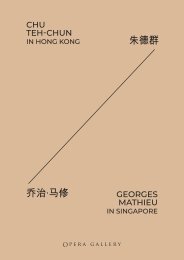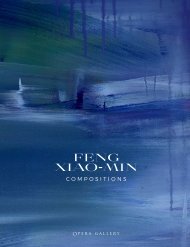David Kim Whittaker 'The Flesh to The Frame'
You also want an ePaper? Increase the reach of your titles
YUMPU automatically turns print PDFs into web optimized ePapers that Google loves.
<strong>The</strong> theme of crucifixion also occurs<br />
throughout <strong>David</strong> <strong>Kim</strong>’s work. Sometimes it is<br />
expressed by a crown of thorns, either seen<br />
in complete detail, or as just two or three<br />
thorns emerging from behind something else,<br />
sometimes, the abstracted bodily form itself<br />
takes on a cruciform shape. For <strong>David</strong> <strong>Kim</strong>, life<br />
often feels like a series of daily crucifixions:<br />
a balanced struggle between the sometimes<br />
harsh realities of physical existence and those<br />
more ethereal and metaphysical dimensions<br />
that allow us <strong>to</strong> transcend it. This is reflected<br />
in his paintings, where sublime landscapes<br />
and bucolic rural idylls merge with exorcisms,<br />
soldiers and the victims of warfare and<br />
famine. But, like Freder, <strong>David</strong> <strong>Kim</strong> unites the<br />
worlds of body and mind through the feelings<br />
he expresses in his paintings: compassion,<br />
care and love caught in luscious colours<br />
and heartfelt brushmarks, reminding us<br />
that however much we may physically and<br />
mentally engage with the world, we must ‘feel’<br />
it emotionally <strong>to</strong> truly be part of it.<br />
Le thème de la crucifixion apparaît aussi dans<br />
l’œuvre de <strong>David</strong> <strong>Kim</strong>. Elle s’exprime parfois<br />
par une couronne d’épines, dépeinte dans son<br />
ensemble, ou seulement par deux ou trois épines<br />
émergeant de l’arrière-plan. Parfois la crucifixion<br />
apparaît sous la forme d’une masse corporelle<br />
abstraite prenant la forme d’une croix. Pour <strong>David</strong><br />
<strong>Kim</strong>, la vie est souvent une série de crucifixions<br />
quotidiennes : une lutte équilibrée entre les réalités<br />
parfois dures de l’existence physique et les<br />
dimensions plus éthérées et métaphysiques qui<br />
nous permettent de la transcender. Cette lutte, c’est<br />
ce qui transparaît dans ses <strong>to</strong>iles où des paysages<br />
sublimes et des idylles pas<strong>to</strong>rales bucoliques se<br />
confondent avec des exorcismes, des soldats et<br />
des victimes de la guerre et de la famine. Comme<br />
Freder dans Metropolis, <strong>David</strong> <strong>Kim</strong> unit les mondes<br />
du corps et de l’esprit par le biais des sentiments<br />
qu’il exprime dans ses tableaux. La compassion, la<br />
bienveillance et l’amour saisis dans des couleurs<br />
vives et des traits de pinceaux <strong>to</strong>ut droit issus<br />
du cœur, nous rappelant que quel que soit notre<br />
engagement physique et mental avec le monde,<br />
nous devons le « sentir » émotionnellement pour<br />
en faire vraiment partie.<br />
Richard Davey is an internationally published<br />
author, cura<strong>to</strong>r and member of the International<br />
Association of Art Critics. He has written<br />
books on Tess Jaray RA and Anthony Whishaw<br />
RA. His catalogue essays include Anselm<br />
Kiefer (Royal Academy, 2014) and the Royal<br />
Academy Summer Exhibition in 2015, 2016<br />
and 2017. He was a judge of the John Moores<br />
Painting Prize 2016.<br />
Richard Davey est un auteur de réputation<br />
internationale, conservateur et membre de<br />
l'Association internationale des critiques d'art. Il<br />
a écrit des ouvrages sur Tess Jaray RA et Anthony<br />
Whishaw RA. Ses catalogues d’exposition sont<br />
consacrés à Anselm Kiefer (Royal Academy<br />
2014) et aux expositions d’été 2015, 2016 et<br />
2017 de la Royal Academy. Il a fait partie du jury<br />
du John Moores Painting Prize 2016.<br />
11


